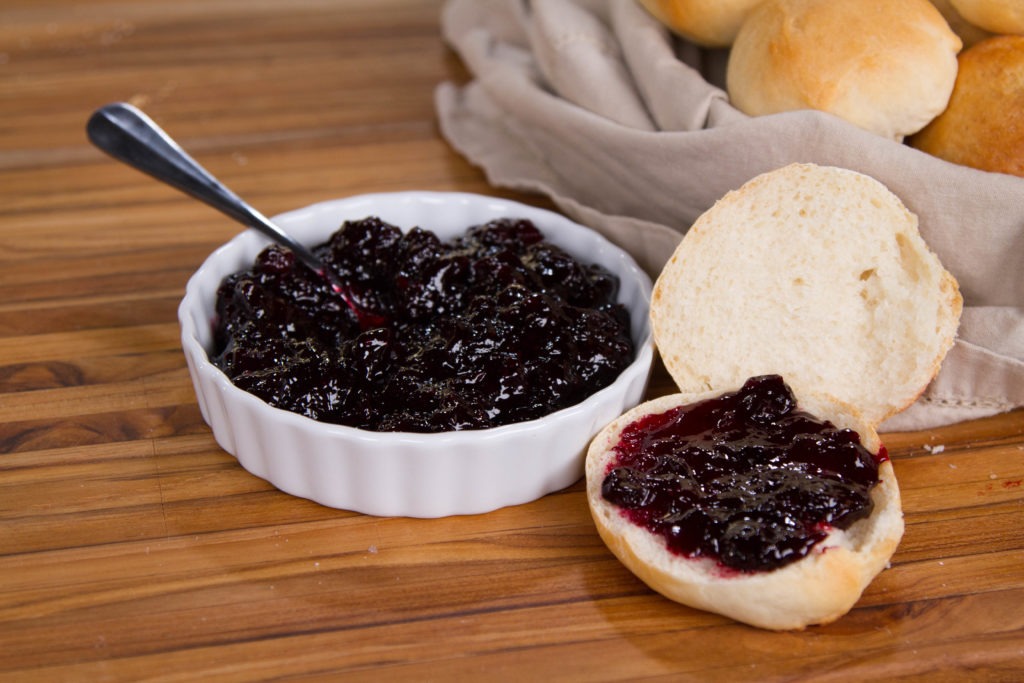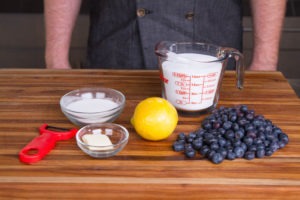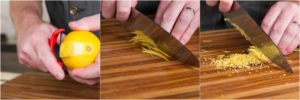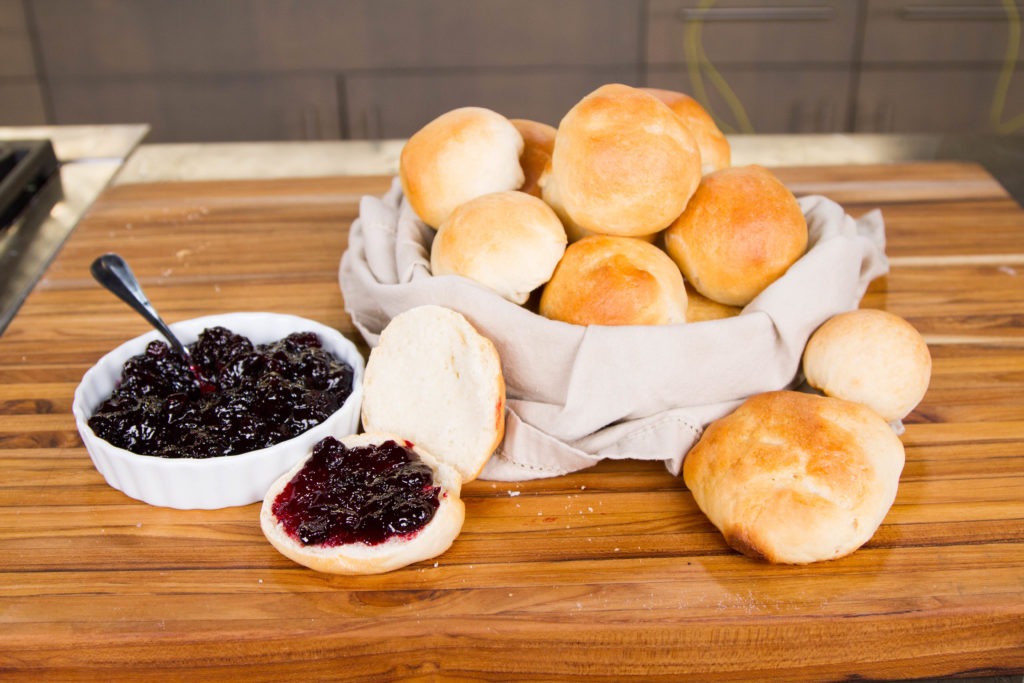Spiced Blueberry Jam
Fruity, sweet, delicious jams are a great weekend project any time of the year. With a summer glutoffresh berries and fruit, you can make crave-worthy jams for your pantry. Or, use a jam like this blueberry version for a sweet accompaniment to game dishes or even steak and fowl. Add a gentle note of spice and it’s honestly perfect for summer or winter. And with our thermal guidelines, you can be sure your jam will be jammy, not runny on your morning toast.
What Makes Jam…Jam?
Pectin
The key to all jams is a natural substance called pectin. Pectin is found naturally in the cell walls of many plants and is part of what gives them structure. Pectin is a polysaccharide, meaning it is a molecule composed of long chains of sugar-like pieces. In a jam or jelly, these pectins form a…
…sponge-like network that traps the water in many separate little pockets… When fruit is cut up and heated near the boil, the pectin chains are shaken loose from the cell walls and dissolve into the released cell fluids and any added water.—Harold McGee, On Food and Cooking, pg 296
The pectin chains don’t immediately gel because they are too diluted in the water to form a network and because they are negatively charged—thus repelling each other.
Overcoming the Dilution Problem
Adding sugar, which attracts and holds on to water, is a necessary step in clearing up the dilution problem. With the diluting water bound up in the more-hydrophilic sugar, the pectin molecules can be close enough together to interact.
Overcoming the Negative Charge Problem
Pectin’s natural negative charge is all that then stands in our way. To overcome the negativity problem we introduce additional acid into the mix, the ions of which neutralize the negative charges on the pectin, allowing them to latch on to one another.
Some fruits have naturally high pectin, obviating the need for added pectins, and some are naturally high in acid, eliminating the need for added citrus juice. Use a pectin-acid table to help you decide if you will need to add either to your preserves. Because blueberries are naturally low in pectin and acid the recipe calls for both.
Gelling heat and concentration
Sugar and acid are, as we see, two of the key factors in making gelled preserves. But they cannot act alone. They must be cooked together long enough to remove the rest of the diluting water from the preserves; and in precisely the same way that we measure sugar concentration in candy making by the boiling point, so too we measure the sugar concentration in preserves by temperature.
Jam makers have long depended upon the cool-plate test for gelling, whereby a few drops of the preserve are dripped onto a pre-cooled plate and allowed to rest for a few moments. The plate is then tipped and the jam maker observes whether or not the jam “wrinkles.” If it does, it is reduced enough to stop cooking; if it rolls freely, it must cook further. But this is ThermoWorks. We can be more precise than that!
The rule for jams gelling (but not marmalades, they behave differently) is to boil it to 8 degrees above water’s boiling point, i.e. 220°F (104°C) at sea level. (To adjust for elevation, subtract 2°F (1.1°C) for every thousand feet above sea level that you live or use our boiling point of water calculator.) And how can we measure that concentration? With a frozen plate? No, with a Thermapen, of course! As long as there is enough pectin in your jam to get the job done (either from the pectin in the fruit or from added pectin), it will gel at this point.
Spiced Blueberry Jam Recipe
Modified from Lucy Baker’s recipe on Seriouseats.com
Ingredients
- 8 cups fresh blueberries (frozen will also work!)
- 4 1/2 cups granulated sugar
- Zest and juice of one lemon
- One (1.75-ounce) package low sugar powdered pectin, such as Sure Jell
- 1/2 teaspoon unsalted butter
- 3 cinnamon sticks
Instructions
- If you are going to preserve the jam, prepare your jars and lids: place 8 half-pint jars on rack in large pot. Add enough water to cover the jars, and bring to boil over high heat. Boil for 10 minutes, then turn off heat and allow jars to rest in the hot water. Meanwhile, put the bands and lids in a small saucepan and cover with water. Heat over medium heat until the water is simmering, then remove pan from heat and allow the bands and lids to rest in hot water until ready to use.
- In a heavy-bottom pot, crush the blueberries, or pulse them in a food processor and transfer to the pot. Add the cinnamon sticks, the lemon zest, and juice to the berries and stir to combine. Add 1/4 cup sugar combined with the pectin as well as the butter. Bring to a boil over high heat, stirring constantly.
- Add the remaining sugar all at once, and stir to combine. Bring to a boil, continuing until temperature reads 220°F (104°C) (elevation adjusted) on your Thermapen. Remove cinnamon sticks.
- Ladle hot jam into hot sterilized jars, leaving 1/4-inch headspace. Wipe rims of the jars, cover with lids, and screw bands on until just barely tight. Place jars on rack in a canning pot and cover completely with water. Cover pot and bring to a boil over high heat. Boil for 10 minutes (also adjusted for altitude). Turn off heat, uncover the pot, and allow jars to rest in water for five minutes. Remove jars from the pot and allow them to rest undisturbed on countertop for six hours or overnight. (For more instructions on canning and preserving jams and jellies, please read from established sources and/or contact your local agricultural extension program.)
- Stock the pantry or distribute jars to friends and neighbors and eagerly await your well-deserved praise.
Jams are a sweet way to use your fresh produce, and with your Thermapen at your side, making them will be just as sweet an experience. use your thermal knowledge to get the results you want for your breakfast all through the year!
Shop now for products used in this post:
References:
Harold McGee, On Food and Cooking
Lucy Baker, Blueberry Lavender Jam Recipe, on seriouseats.com
Ball Mason Jars










Hello, Wouldn’t the Thermo-pop also read the temperature needed?
Kathy,
Yes! A thermoPop would absolutely do the trick here. There is a greater degree of accuracy with the Thermapen, but the temperature goal is not so narrow as to make that a necessity. By all means, use your ThermoPop!